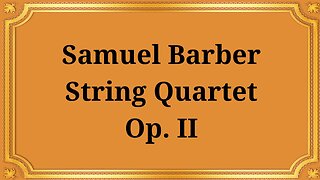Premium Only Content

Maurice Ravel Rapsodie Espagnole
Maurice Ravel's Rapsodie Espagnole is a captivating and dynamic orchestral piece that showcases the composer's signature style of impressionism. Written in 1907-08, the work consists of four movements, each inspired by Spanish folk music and culture.
Maurice Ravel began composing Rapsodie Espagnole in 1907, during a period when he was deeply influenced by Spanish music and culture. He had recently returned from a trip to Spain, where he attended numerous flamenco performances and was fascinated by the intricate rhythms and melodies of Spanish folk music.
The piece was premiered in Paris in 1908, conducted by Paul Paray. Initially, the work was received with mixed reviews, with some critics dismissing it as "an imperfect attempt to capture the essence of Spanish music." However, Rapsodie Espagnole soon became one of Ravel's most popular works, and today it is regarded as a masterpiece of orchestral music.
Rapsodie Espagnole consists of four movements:
Prelude a la nuit (Prelude to the Night) - The first movement features a dreamy and romantic melody played by the woodwinds and strings. The music gradually builds in intensity, with the addition of brass and percussion, before fading away into a quiet and mysterious conclusion.
Malaguena - The second movement is a lively and rhythmic dance inspired by the traditional Malagueña style of Andalusia. The music features a prominent castanet rhythm, which is played by the percussion section, and a catchy melody played by the clarinet and trumpet.
Habanera - The third movement is a slow and sultry dance that is characterized by a distinctive rhythm and melody. The music is marked by the use of glissandos in the strings and a solo violin that plays a mournful melody.
Feria - The final movement is a festive and energetic dance that evokes the atmosphere of a Spanish fair. The music is characterized by a fast and complex rhythm, with multiple themes that are woven together in a grand finale.
Rapsodie Espagnole is known for its distinctive harmonies, colorful orchestration, and inventive use of rhythm. Ravel's use of Spanish folk melodies and rhythms was groundbreaking at the time, and it helped to establish him as one of the leading composers of the early 20th century.
The piece is also notable for its use of orchestral color, with each movement featuring a unique combination of instruments and timbres. For example, the Habanera features a solo violin that is accompanied by muted trumpets and pizzicato strings, creating a distinctive and evocative sound.
In conclusion, Maurice Ravel's Rapsodie Espagnole is a masterpiece of orchestral music that showcases the composer's unique style and innovative use of Spanish folk music. With its captivating melodies, complex rhythms, and colorful orchestration, Rapsodie Espagnole continues to captivate audiences over a century after its composition.
Maurice Ravel Rapsodie Espagnole
1 Ravel Rapsodie Espanole 00:00
2 Ravel Rapsodie Espanole 02:02
3 Ravel Rapsodie Espanole 06:09
4 Ravel Rapsodie Espanole 08:36
#classical_music #Maurice_Ravel #Rapsodie_Espagnole #classical_music
-
 16:45
16:45
Classical music_Music Inspiration
17 days agoSamuel Barber String Quartet, Op. II
552 -
 18:06
18:06
Professor Gerdes Explains 🇺🇦
14 hours agoAfter Major Attack, Trump Vows "Phase II" Sanctions on Russia
3.78K7 -
 LIVE
LIVE
EVASIVE_rabbi
4 hours ago✅️ 2 Dumb Navy Vets & A First Playthrough #Coop ✅️
73 watching -
 LIVE
LIVE
Cook14u
8 hours agoSeahawks Let Me Down, DO NOT Talk About How I Look 🤐🙃🥴
16 watching -
 8:18
8:18
MattMorseTV
15 hours ago $9.28 earned2.2 MILLION in ONE YEAR.
64.4K144 -
 LIVE
LIVE
TheKappaConvict
2 hours agoRainbow Six Siege X Lets send Em Packing Boys | The kappa Convict
6 watching -
 1:05:18
1:05:18
Steve-O's Wild Ride! Podcast
3 days ago $6.89 earnedYUNGBLUD Stands Up For His Generation | Wild Ride #265
67.7K14 -
 12:11
12:11
Nikko Ortiz
2 days agoCrashout 6 Rumble
94.1K9 -
 19:56
19:56
GritsGG
15 hours agoSpectating Random Solo Players in a Bot Lobby!
11.4K1 -
 LIVE
LIVE
Lofi Girl
2 years agoSynthwave Radio 🌌 - beats to chill/game to
397 watching